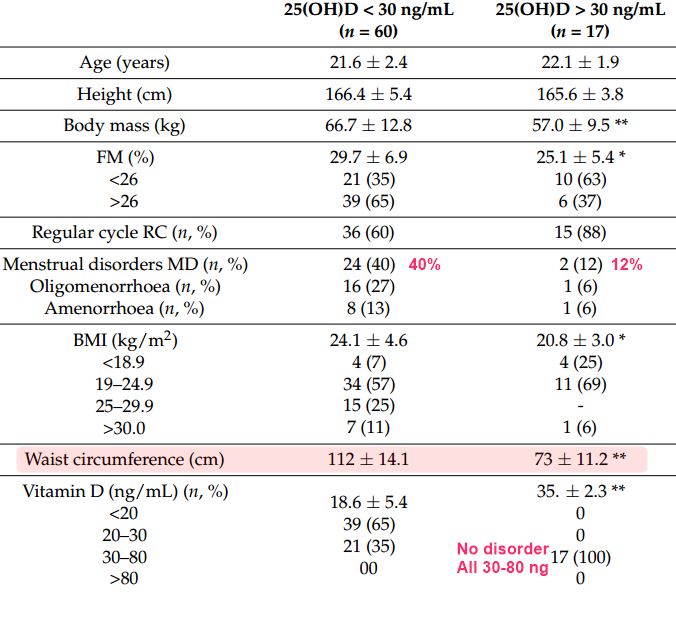Menstrual cycle disorders 5X more likely in teens if less than 30 ng of Vitamin D
The Relationship between Vitamin D Status and the Menstrual Cycle in Young Women: A Preliminary Study.
Nutrients. 2018 Nov 11;10(11). pii: E1729. doi: 10.3390/nu10111729.
| <30 ng | 30-80 ng | |
| Long cycles | 40 % | 12 % ? |
| Oligomenorrhoea | 27 % | 6 % |
| Amenorrhoea | 13 % | 6 % |
📄 Download the PDF from VitaminDWiki


BACKGROUND: The aim of this study was to evaluate serum vitamin D levels and to compare these with the menstrual cycle in young women with different body weights.
METHODS: Eighty-four students were recruited into the study of which 77 remained at the study's completion. Women were assigned to one of two subgroups, according to their 25-hydroxy vitamin D test level [25(OH)D] in which 60 women had low 25(OH)D levels (LD < 30 ng/mL) and 17 had normal levels (ND > 30 ng/mL ≤ 80 ng/mL).
RESULTS: In the LD group, 40% of participants reported having long cycles, 27% were classified as having oligomenorrhoea, and 13% as having amenorrhoea. In the ND group, only 12% reported menstrual cycle disorders, 6% had oligomenorrhoea, and 6% had amenorrhoea. Women who did not meet the recommended level of 30 ng/mL of 25(OH)D had almost five times the odds of having menstrual cycle disorders as women who were above the recommended vitamin D level.
CONCLUSION: A relationship was demonstrated between the frequency of menstrual disorders and low levels of vitamin D. Supplementation is necessary in women with low levels of vitamin D in order to compensate for this deficiency and to assess its effect in regulating menstrual disorders.
